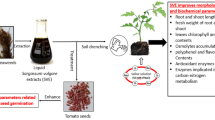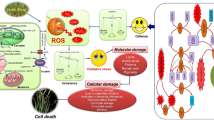Abstract
Fruit bodies of Auricularia auricula-judae are often subjected to drought stress and became dormant. The responses of antioxidant defenses and membrane damage to drought stress were investigated in this study. Picked fruit bodies were exposed to sunlight and dehydrated naturally and samples were collected at different levels of water loss (0, 10, 30, 50, and 70 %) for determination of electrolyte leakage (EL); contents of malondialdehyde (MDA), ascorbic acid (AsA) and reduced glutathione (GSH); and activities of superoxide dismutase (SOD), catalase (CAT) and peroxidase (POD). Results showed that membrane permeability (assessed by EL) and membrane lipid peroxidation (MDA content) remained unchanged at all levels of water loss studied. Contents of AsA and GSH showed no change at 0, 10 and 30 % of water loss, however, both of them increased significantly at 50 and 70 % of water loss. SOD activity significantly increased with the rising of water loss from 0 to 30 %, reached the peak at 30 and 50 % of water loss, and then significantly decreased at 70 % of water loss. A gradual increase in POD and CAT activities was observed when water loss rose from 0 to 50 %. As water loss went up to 70 %, POD activity remained the same as that at 50 %, but CAT activity decreased. The results indicate that the increased activities of enzymatic antioxidants (SOD, CAT and POD) and contents of non-enzymatic antioxidants (AsA and GSH) in fruit bodies of A. auricula-judae can effectively scavenge reactive oxygen species, cause no damage to cell membranes as demonstrated by the unchanged EL and MDA content, and contribute to dormancy under drought stress.



Similar content being viewed by others
References
Ahmad P, Sarwat M, Sharma S (2008) Reactive oxygen species, antioxidants and signaling in plants. J Plant Biol 51:167–173
Bowler C, Montagu MV, Inze D (1992) Superoxide dismutase and stress tolerance. Annu Rev Plant Physiol Plant Mol Bol 43:83–116
Christensen CM (1981) Edible mushrooms, 2nd edn. University of Minnesota Press, Minneapolis
Ferreira IC, Barros L, Abreu RM (2009) Antioxidants in wild mushrooms. Curr Med Chem 16:1543–1560
Gill SS, Tuteja N (2010) Reactive oxygen species and antioxidant machinery in abiotic stress tolerance in crop plants. Plant Physiol Biochem 48:909–930
Guo ZF, Huang MY, Lu SY et al (2007) Differential response to paraquat induced oxidative stress in two rice cultivars on antioxidants and chlorophyll a fluorescence. Acta Physiol Plant 29:39–46
Guo Y, Tian Z, Yan D et al (2009) Effects of nitric oxide on salt stress tolerance in Kosteletzkya virginica. Life Sci J 6:67–75
Hameed A, Iqbal N, Malik SA (2009) Mannose-induced modulations in antioxidants, protease activity, lipid peroxidation, and total phenolics in etiolated wheat leaves. J Plant Growth Regul 28:58–65
Kim S, Tai TH (2011) Evaluation of seedling cold tolerance in rice cultivars: a comparison of visual ratings and quantitative indicators of physiological changes. Euphytica 178:437–447
Liu GY (2005) A new method for tissue separation of edible fungus (Auricularia auricula-judae). Guizhou Agricultural Sciences 1:73 (in China)
Liu XZ, Huang BR (2000) Heat stress injury in relation to membrane lipid peroxidation in creeping bentgrass. Crop Sci 40:503–510
Lutts S, Kinet J, Bouharmont J (1996) NaCl-induced senescence in leaves of rice (Oryza sativa) cultivars differing in salinity resistance. Ann Bot 78:389–398
Qin LQ, Li L, Bi C et al (2011) Damaging mechanisms of chilling-and salt stress to Arachis hypogaea L. leaves. Photosynthetica 49:37–42
Scandalios JG (1993) Oxygen stress and superoxide dismutases. Plant Physiol 101:7–12
Sies H, Stahl W (1995) Vitamins E and C, beta-carotene, and other carotenoids as antioxidants. Am J Clin Nutr 62((Supple)):1315S–1321S
Watling R (1971) Basidiomycetes: homobasidiomycetidae. In: Booth C (ed) Methods in microbiology, vol 4. Academic press, New York, pp 219–236
Xia H, Xu JP, Meng XL et al (2011) The fusion protein penhrp containing Penaeidin-2 and HarpinZ induced a stronger hypersensitive response and systemic acquired resistance in tobacco comparing to the original HarpinZ. Aust Plant Pathol 40:141–148
Yan B, Dai Q, Liu X et al (1996) Flooding-induced membrane damage, lipid oxidation and activated oxygen generation in corn leaves. Plant Soil 179:261–268
Acknowledgments
This work was financially supported by the Nation Natural Science Foundation (31272484) of china.
Author information
Authors and Affiliations
Corresponding author
Rights and permissions
About this article
Cite this article
Ma, H., Xu, X. & Feng, L. Responses of antioxidant defenses and membrane damage to drought stress in fruit bodies of Auricularia auricula-judae . World J Microbiol Biotechnol 30, 119–124 (2014). https://doi.org/10.1007/s11274-013-1416-z
Received:
Accepted:
Published:
Issue Date:
DOI: https://doi.org/10.1007/s11274-013-1416-z




